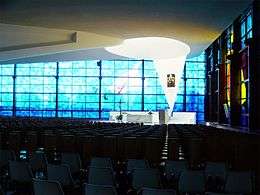Santuario della Madonna del Divino Amore
| Shrine of Our Lady of Divine Love Santuario della Madonna del Divino Amore (Italian) | |
|---|---|
|
Santuario della Madonna del Divino Amore | |
| Basic information | |
| Location |
Via Ardeatina 1221 - 00134 Roma (06 71 35 51 21) |
| Geographic coordinates | 41°46′43.5″N 12°32′37.9″E / 41.778750°N 12.543861°ECoordinates: 41°46′43.5″N 12°32′37.9″E / 41.778750°N 12.543861°E |
| Affiliation | Roman Catholic |
| Ecclesiastical or organizational status | Parish church, shrine, one of the Seven Pilgrim Churches of Rome |
| Website |
www |
| Architectural type | Church |
Santuario della Madonna del Divino Amore or the shrine of Our Lady of Divine Love is a Roman Catholic shrine dedicated to the Blessed Virgin Mary that consists of two churches: an old church built in 1745 and a new church added to the sanctuary in 1999. The church was included by Pope John Paul II in the pilgrimage of Seven Pilgrim Churches of Rome during the Holy Year 2000.[1]

History
In 1295 the property belonged to the Savelli, who built a castle surrounded by a boundary wall, sandwiched by six or eight towers. By the early eighteenth century, the estate had fallen into ruin. One of the towers of a gatehouse, known as the Castel di Leva, was decorated with a medieval fresco, a votive image of the Madonna and Child.[2] Local shepherds who grazed their flocks nearby during the winter would often meet here to pray the Rosary.[3] In 1740, a pilgrim was attacked by angry dogs near the gatehouse and, according to the tradition, was saved through the intercession of the Blessed Virgin Mary. As a result of the number of pilgrims drawn to this site, a chapel was built and the image of the Madonna was transferred to it.
With the increase of devotion from the people in the countryside, the church was entrusted to a hermit guardian, the first of which was Pasquale Francesco. After the fall of the Papal State in 1870 and the confiscation of church property, the property again falls into a period of neglect and decay, although the devotion of the faithful to Our Lady of Divine Love continues. In December 1932, a parish is established and Don Umberto Terenzi, appointed Rector and the first parish priest. In March 1942 he founded the Congregation of the Daughters of Our Lady of Divine Love.[3]
During World War II, the fresco was moved to the church of St. Ignatius. Pope Pius XII and many Romans visited the shrine to pray for the Holy Mother's intercession that the city be spared. On June 11, 1944 Pius XII went to pray before the Image of the Virgin, surrounded by an immense crowd, and bestows the title of Salvatrice dell'Urbe.[3] In 1962, the Oblate Priests were founded, who since then serve the shrine. The pilgrimages increase, especially from Whit Monday until autumn. The shrine presently on the site is new, and was inaugurated by Pope John Paul II on July 4, 1999. Pope John Paul II decided to include the shrine in the Seven Pilgrim Churches of Rome and the corresponding pilgrim itinerary for the Holy Year 2000, replacing San Sebastiano fuori le Mura.
Behind the chapel is a staircase that leads down to the gate tower where the miracle occurred in 1740.
Interior
The miraculous painting is enshrined above the altar. The mosaics in the apse are modern, and shows Christ in the centre, and the miracle on the left.
In the crypt one will find the tomb of the married couple Bl. Luigi (Aloysius) Beltrame Quattrocchi and Bl. Maria Corsini Beltrame Quattrocchi. He died in 1951, and she in 1965. After their deaths, a beatification process was started. They were beatified on 21 October 2001 by Pope John Paul II, and this was the first time that a married couple had been beatified together. Their relics were moved here on 28 October 2001. The feast of Bl. Luigi and Maria Corsini Beltrame Quattrocchi is celebrated on 25 November, their wedding day.
References
- ↑ Kim, Tony. An American Story. Dorrance Publishing.
- ↑ Official website (2011). "History of the sanctuary of our Lady of Divine Love". santuariodivinoamore.it. Retrieved 3 April 2013.
- 1 2 3 Morra, Mario. "Our Lady of Divine Love", Santi e Beati
Further reading
- Pietra, Pierluigi (1958). La Madonna del Divino Amore: il suo santuario, la sua opera (in Italian). Retrieved 3 April 2013.
- Garella, Luciano (2007). Il Divino Amore a Roma: storia della costruzione (in Italian). Gangemi. ISBN 978-88-492-1238-9. Retrieved 3 April 2013.
External links
 Media related to Santuario della Madonna del Divino Amore (Rome) at Wikimedia Commons
Media related to Santuario della Madonna del Divino Amore (Rome) at Wikimedia Commons- The Vatican: spirit and art of Christian Rome, a book from The Metropolitan Museum of Art Libraries (fully available online as PDF), which contains material on the Santuario